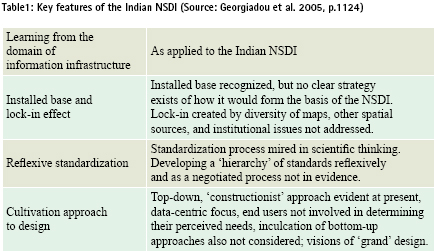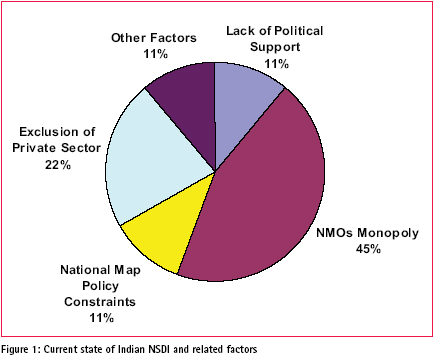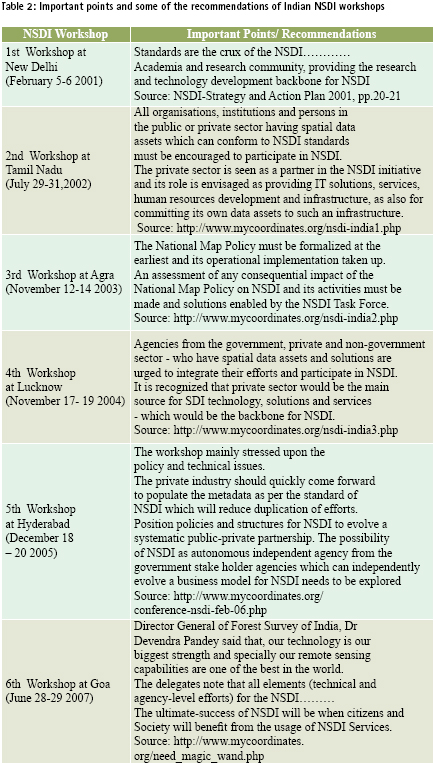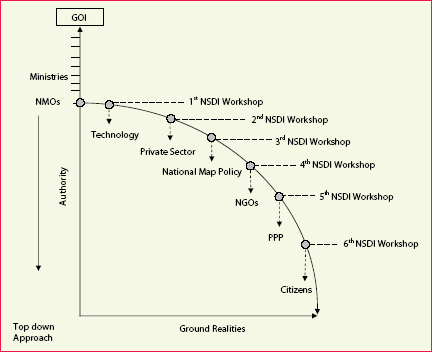| SDI | |
Is Indian NSDI an example to follow?
|
Asmat Ali
|
||||||
|
Special characteristic of spatial data is that it can be shared and used for many other purposes than the one, for which, it was originally produced. To facilitate its efficient sharing and reuse, it needs to be properly managed in the form of infrastructure i.e. Spatial Data Infrastructure (NSDI). This is one of the reasons that many countries are developing National Spatial Data Infrastructure (NSDI). But the challenge of developing a successful NSDI depends largely on its implementation which is so significant that none of the two key stakeholder groups i.e. public or private sectors can address it at their own. Therefore, if efforts are made to implement such initiatives by only one of the key stakeholder groups then the result may be partially if not totally failure to get the tangible benefits truly intended from such initiatives. As an example, Indian NSDI is explored in this context. Indian NSDI is not new to the spatial community as it was initiated eight years ago. During these eight years it has gone through different phases i.e. conceptualization to implementation. A lot has been written and is still being written by the spatial community about the Indian NSDI. This paper explores overall trajectory of Indian NSDI up till now. It is believed that tracking Indian NSDI trajectory would be helpful for countries such as Pakistan which are in the initial process to start such initiative. How and by whom Indian NSDI was conceptualized?The task force which envisioned NSDI was composed of geographers, scientists, GIS experts, administrators, mainly drawn from survey, mapping, remote sensing, and the Indian space organizations (ibid., p.Tf.1).Strategy and action plan for Indian NSDI was launched at a workshop held in New Delhi from 5th to 6th February 2001 which briefly explained vision of Indian NSDI. Statement of ‘The NSDI Vision’ is, “National infrastructure for the availability of and access to organised spatial data use of the infrastructure at community, local, state, regional and national levels for sustained economic growth”, (NSDIStrategy and Action Plan 2001, p.6). A letter to NSDI Task Force from Department of Space describes, “… technical agreements, standards, metadata definitions, network and access protocols will it be easily possible for the NSDI to come into existence”, (NSDI-Strategy and Action Plan 2001, p.4). Similarly in another letter, it is stated that, “There is a widespread consensus, internationally, that spatial data sets need to be integrated to create what is called a geo-spatial data infrastructure. Such infrastructures have been linked to information highways, linking a variety of databases and providing for the flow of information from local to national levels and eventually to the global community” (DST 2001, p. 5, foreword by Secretary, DST). Also in another letter market place is the focus of potential NSDI, “In the emerging market-place, geographic or geo-spatial information occupies a preeminent position”, (DST 2001, p. 5, foreword by Secretary, DST). Puri, Sahay and Georgiadou in a paper presented in GSDI-9 conference at Santiago, Chile in 2006 take note of this borrowed concept and say, “…….the approach adopted to the setting up of the NSDI in India, focusing particularly on how it has been inspired by the “superhighway’ and “marketplace” metaphors”. What were elements of Indian NSDI?A research was carried out in 2004 by Georgiadou, Puri and Sahay, “To understand the perspectives of stakeholders involved in the planning, implementation, and eventual end use of the proposed NSDI”, (Georgiadou et al. 2005,p.1117). They note that “The key elements identified for development of NSDI were: standards (to allow interoperability; standards for networks, gateways, protocols, software, etc.), evolving metadata, nodes (GIS-based spatial database servers), search and access protocols, electronic clearing house, creating user interfaces, and initiating an NSDI outreach and awareness programme”, (Georgiadou et al. 2005,p.1118). Looking at the elements, one can find that except “an NSDI outreach and awareness programme” rest of the ingredients of Indian NSDI were purely technology biased. More over, partnership element is missing. According to Katleen et al. (2006, p. 1) , “The development of a spatial data infrastructure (SDI) not only comprises technical aspects, but also is supported by economic, social, organizational and legal measures”, (Katleen 2006). Keeping in view the aspects defined by Katleen et al. following elements appear missing or were not in place, i.e. economic, social, organizational and legal. Puri et al. (2006, p. 6) quotes statement of a senior executive working in large private sector organization who expressed his disenchantment in the following words: “NSDI was conceptualized and is being implemented by the government, for the government, within the bureaucratic framework of the government… We would not participate in NSDI unless it is established outside the pale of the government, and functions as an enlightened, independent body”. This and other statements quoted above speak of lack of private sector participation in Indian NSDI. Realizing the power and usefulness of innovative approach i.e. Public-Private Partnership (PPP), Indian Union Minister for Science and Technology Kapil Sibal in his statement published on the website of a magazine, GIS Development on 20th February 2007, said that there will be just a few restrictions on the use of data. And “This (the project) will be rolled out through public-private partnerships (PPPs)”, he added. http://www.gisdevelopment.net/news/viewn.asp?id=GIS:N_npqesowhvy). Puri, Sahay and Georgiadou conclude, “… in a state controlled domain where the private sector has literally had no role to play until recently, and where the use of maps is not historically evident (Sahay & Walsham 1997), the assumptions of a marketplace approach remain in contradiction with the historical realities on the ground”, (Puri et al. 2006, p. 6). This supports the fact that users and private sector were not considered in Indian NSDI. Simply said it was not based on PPP because in PPP, public organizations, private organizations, NGOs, academia, and citizens all are included. Masser also showed concerns about Indian NSDI in an article published on website (http://www.gisdevelopment. net/policy/gii/gii0009pf.htm) of GIS Development, a magazine from India. He doubts inclusion of all stakeholders, “The proposed National Geospatial Data Infrastructure is a major step forward for India. Its implementation will require the active involvement of all the geographic information stakeholders”, (Masser 2004). Recommendations made by the delegates during the NSDI-VI workshop held at Goa during 28-29 June, 2007 clearly reflects exclusion of private sector in Indian NSDI as published on website (http:// www.mycoordinates.org/) of a monthly magazine “Coordinates” in its July 2007 issue. One of the recommendations was to “Recognize that the datasets generated in the private sector have got potential for many applications and thus be made part of NSDI metadata. The private industry should quickly come forward to populate the metadata as per the standard of NSDI which will reduce duplication of efforts”. Which stakeholders were considered?It is also important at the outset to identify some of the most important players or stakeholders with interests in geographic information and spatial data infrastructure matters (Masser, 2005). These most important stakeholders are: central government organizations, local government organizations, commercial sector (such as data producers, brokers who add value to core datasets, publishers, hardware and software vendors etc), NGOs, academia and citizens. Indian NSDI has sixteen stakeholders and they are all national agencies according to the website (http://gisserver.nic.in/ nsdiportal/gotogos.jsp). Puri et al. (2006) finds that the users have been almost totally neglected during the NSDI design. The attitude of public sector organizations is stated in an article published on 19th Feb 2007 in The Times of India in these words, “Getting information out of government is a bit like getting blood from a stone”. Private sector also sufferedthe same as they were also not involved in NSDI development. Where as a strong private GIS market exists in India mentioned by science and technology minister Kapil Sibal in a statement published by The Times of India on 19th February, 2007. The minister said in his statement, “in any case, there are already 200 firms in the GIS business in India”. As a result later on Indian NSDI faced serious difficulties at implementation stage which caused significant delay in getting tangible benefits from it. Establishment of National Spatial Data Committee (NSDC) in 2006 further strengthened grip of Indian bureaucrats instead of social sector, end users and private GI sector organizations over Indian NSDI. The role of NSDC as stated by Coordinates in its July 2006 issue is, “The NSDC shall be the apex national authority for formulating and implementing appropriate policies, strategies and programmes for the establishment, operation, management of the NSDI and utilistation and any other activities related to spatial data in the country”. The committee is totally void of private sector membership. The National Spatial Data Committee (NSDC) constituted with the members all belonging to public sector organizations as reports the website http://www.mycoordinates. org/indias-nsdi-july06-1.php. |
||||||
|
Asmat Ali |
|
The exclusion of end users also made it impossible to bring social aspects of NSDI in the terminology of Georgiadou ‘Social SDI’ and it became a ‘technical SDI’. About the exclusion of state governments, the then Surveyor General of India in the July 2006 issue of Coordinates (http:// www.mycoordinates.org/indias-nsdijuly06. php) said, “The other area of concern is to involve state governments. We need to think how to get them on board through state level SDI”. And “Although major data producing agencies are at central level but at micro level most of the datasets are with the state governments” he further added. He also realized the difficulties of implementation saying that, “The challenge as Member Secretary is the implementation of an action plan within a given timeframe”. In the February 2006 issue of GIM International (http://www.giminternational. com/issues/articles/id614- Multilevel_Implementation_of_SDIs. html), Masser writes, “Many national SDI documents seem to abide by the principle of ‘one size fits all’; they suggest that the outcome of SDI implementation will lead to a relatively uniform product…… National SDI strategies drive statewide SDI strategies and state-wide SDI strategies drive local-level SDI strategies”. Therefore, participation of local stakeholders i.e. states, end users, private sector GI organizations, academia and NGOs is very crucial for implementation of an NSDI. As most detailed database maintenance and updating tasks are carried out at local level, the input of local government has a considerable impact on SDI implementation at state and national levels, (Masser 2005). In the August 2007 issue of Coordinates (http://www. mycoordinates.org/nsdi_august2007.php) Mukund Rao former president GSDI also showed his concerns about participation of few stakeholders in Indian NSDI in these words, “….was driven by a few individuals for success and benefit in the country”. He also underscores the need of PPP for NSDI in these words, “Another major amalgam for NSDI is Public-Private partnerships – it would be just impossible for a single entity (even government) to fully establish the NSDI on its own. Partnerships will have to be the core mechanism to make NSDI successful.” How was Indian NSDI implementated?NSDI implementation is a complex process. In addition too many stakeholders in the game as is the case of Indian NSDI make it more complex. The gravity of the situation increases further when major players are not included such as private sector and end user groups which is true also in Indian case as Georgiadou et al. (2005) also finds, “The Indian NSDI shows little evidence of systematic interaction between its developers (the scientific institutions) and potential end users (for example, district administration) to understand their information needs”, (p.1123). There is no much evidence of any partnership arrangements including PPP though “PPP” is there on papers of Indian NSDI workshops and in the statements given by Indian ministers to the print media. To quote an example, science and technology minister Kapil Sibal said in a statement published by The Times of India on 19th February, 2007, “The government proposes to make all this information available through public-private partnerships”. Indian NSDI followed top-down approach termed as “construction approach” by Georgiadou giving it bit mechanical meaning. According to her, “The topdown approach is required to specify a strategic goal and vision, prioritize plans, arrange core funding, contribute to the definition of fundamental datasets, build a clearing house, develop metadata standards, and resolve information policy issues”, (Georgiadou et al. 2005, p.1123). Simply said it revolves around planning and lacks in implementation terms as implementation is more encouraged by bottom-up approach because implementation requires local participation which is present in bottom-up approach according to Georgiadou et al, “The bottom-up approach aim to promote various local initiatives”…, (Georgiadou et al. 2005, p.1123). Therefore, adoption of top-down approach in addition to the exclusion of key stakeholder groups like private sector, academia and NGOs made successful implementation of Indian NSDI a dream instead of reality. What has been the over all trajectory of Indian NSDI?A questionnaire was designed and distributed via e-mail to get input from individuals of public and private GI sector organizations in India. The questionnaire response rate was 60%. Some of the respondents sent very detailed e-mails in addition to questionnaire reply in the context of Indian NSDI. It indicated keen interest of individuals both from public and private GI sector of India regarding NSDI. Most of the respondent i.e. 45% individuals declared monopoly of national mapping organizations (NMOs) as the main reason for current state of Indian NSDI. 22% respondents were of the opinion that Indian NSDI suffered due to exclusion of private sector where as 11% individuals considered national map policy the major bottle neck in successful implementation of Indian NSDI. The same majority i.e. 11% attributed current state of Indian NSDI to lack of political support while remaining 11% respondent considered it due to other factors such as noninvolvement of NGO and academia etc. The result of the survey is displayed in figure 1. Workshops arranged by coordinating body of Indian NSDI also help to understand path followed by Indian NSDI. The following table (Table 2) summarizes the important points and some of the recommendations of Indian NSDI workshops held so far in order to have a brief view of Indian NSDI initiative as perceived by the NSDI coordinating body. Arguments made up till now covered some important aspects such as important elements, stakeholders, partnership arrangements and implementation strategy of Indian NSDI. Therefore, starting from vision statement in 2001 to last NSDI workshop held at Goa in 2007, marks the trajectory of Indian NSDI. |
|
Asmat Ali |
||||||||||||
|
From above figure it is concluded that the overall trajectory of Indian NSDI development has been: 1. Launch of Indian NSDI by national mapping organizations (NMOs) along vertical hierarchy axis (authority) instead of floating it from horizontal axis (ground realities) gave it power of minorities (officials) and not power of the majority (masses). Consequently, it started to decline soon after wards. ConclusionThe overall trajectory of Indian NSDI development has been, initial focus on technology instead of beneficiaries of this technology such as citizens, noninvolvement of private sector, outdated national map policy, neglecting role of NGOs, lack of partnerships such as PPP and top down approach. RecommendationsCountries such as Pakistan which are in the processing of initiating NSDI move, should not follow exactly the same trajectory as of Indian NSDI but floating it with the inclusion of all key players of NSDI such as private sector, public sector, NGOs, research and teaching institutions, and media etc. Reference:* Georgiadou, P. Y. (2003). Reflections on the Indian NSDI National Spatial Data Infrastructure. Geospatial today : strategic renewal to geospatial world. |
||||||||||||
|
||||||||||||
|

















 (No Ratings Yet)
(No Ratings Yet)




